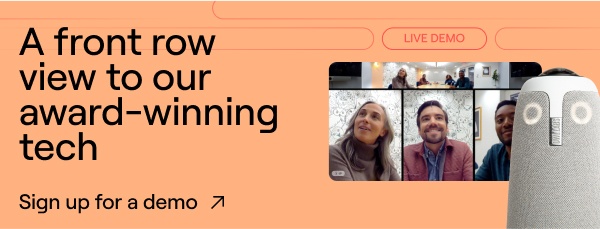We’re thrilled to introduce our new “Modes” characteristic — a robust new technique to take management of your Assembly Owl’s digital camera, providing you with extra management and suppleness over each assembly. However with nice energy comes nice duty… to decide on the proper mode in your assembly!
Don’t be concerned, we’re right here to assist, and there is not any must really feel overwhelmed. Consider this as your pleasant information to navigating the fantastic world of Modes. We’ll break down every one and offer you some real-world examples of when to make use of it, so you possibly can spend much less time fidgeting with settings and extra time having productive (and dare we are saying, enjoyable?) conferences.
Auto Focus Mode: The previous devoted
When you’re a long-time Assembly Owl person, you may really feel proper at residence with Auto Focus. That is the basic, clever setting you already know and love. The Owl’s 360-degree digital camera routinely hones in on whoever is talking, making a dynamic, split-screen view of the newest individuals. It is like having a tiny director within the room, making certain everybody feels seen and heard.
When to make use of it: Auto Focus is your go-to for most traditional conferences. Suppose staff huddles, board conferences, or any dialogue the place the dialog flows freely across the desk. It is the “set it and overlook it” mode that simply works. For longer tables, you possibly can even pair two Assembly Owls to increase the digital camera’s attain and preserve everybody within the body.
Panorama Mode: The “see all of it” expertise

Ever want your distant attendees may have a chicken’s-eye view of all the room? With Panorama mode, they will. This mode takes a 360 view, splits it in half, after which seamlessly stacks the 2 views in two halves, so nothing and nobody will get disregarded.
When to make use of it: Panorama is ideal for whenever you wish to create a extra immersive expertise in your distant individuals. It is nice for vigorous discussions the place physique language and visible cues are simply as necessary because the spoken phrase. Suppose design critiques, collaborative workshops, or any assembly the place seeing the “massive image” is vital.
Speaker Mode: The star of the present

Have a presenter who likes to tempo, gesture, and usually personal the stage? Speaker mode is their new greatest pal. This mode follows the first speaker as they transfer across the room, preserving them entrance and heart for distant attendees. It is like having a private digital camera operator, with out the hefty price ticket.
When to make use of it: Speaker mode is good for shows, lectures, or any state of affairs the place one individual is main the dialogue. It ensures that the speaker stays the main focus, even when they’re transferring round to have interaction with completely different elements of the room.
Handbook Mode: Whole management, on demand

For these moments when you already know precisely what you wish to concentrate on, there’s Handbook mode. This mode permits you to lock the digital camera’s view on a particular space of the room, providing you with full management over what your distant attendees see. No extra automated switching or zooming, only a regular, centered view.
When to make use of it: Handbook mode is ideal for static shows the place the speaker or topic is not transferring. Consider a gaggle mission presentation in a classroom, a product demonstration at a commerce present, or any state of affairs the place you wish to preserve the concentrate on a selected individual or object.
Grid Mode: The Brady Bunch impact

Wish to give everybody their very own little field of fame? Grid mode is the reply. This mode creates a grid of as much as eight in-room individuals, giving every individual their very own devoted video feed. It is a good way to make sure that everybody feels equally represented and included within the dialog.
When to make use of it: Grid mode is ideal for conferences the place you wish to encourage equal participation from everybody within the room. It is a good way to place names to faces and create a extra private connection together with your distant attendees. Strive it in your subsequent staff check-in or digital espresso break!
We’re so excited to see how you employ these new Modes to make your conferences much more participating and productive!










